| Home
What's New
Rangefinders
Fixed Lens
TL & DTL
XTL & X-1000
MSX & DSX
NC1000
Z-Series
Other Mamiya
Instruction
Manual
Reprints
Related Links
Mamiya
35mm Camera
Auction Prices
Mamiya
SLR Lenses
Auction
Prices
Rest of My
Collection
FAQ
Mamiya 35mm
Forum!
How To!

Your Donations
Help Fund This Site.
Thanks for Your
Continued Support!
|
Mamiya, Canon, and Osawa *
In the early 1960s, Osawa was wholesaling both Mamiya and Canon cameras in
Japan. From product evidence it seems likely that someone, probably at Osawa,
decided a few mutual product development programs between the companies
would be a good thing. However it came about, this collaboration engaged in
SLR activity that, while a sideline to the main story of Mamiya camera
development, nevertheless resulted in products worthy of mention.
The Mamiya Prismat
NP, with a Canon OM lens in an Exacta mount (the only Canon
lens ever to appear on any Mamiya 35mm camera, if you don't count
the re-branded NP versions), seems to have been the first fruit of
the collaboration. Mamiya made several lenses for this configuration,
but the Japanese buyer could also equip his Prismat with a Canon OM
50mm f/1.9 lens ("OM" apparently stood for "Osawa/Mamiya" and has
no connection at all with the use of these initials by Olympus).
I say "Japanese buyer" because this Mamiya/Canon combination was never
officially exported to the United States, although it has been reported
that Olden Camera in New York City did acquire some of them through
a special deal with Osawa, and advertised them with full page ads
in magazines such as "Popular Photography" (if anyone has one
of these Olden Camera ads from the early 60s, I would certainly appreciate
a copy).
The Mamiya Prismat series was remarkable in many ways. Mamiya's
first SLR, another model was their first SLR with a leaf-shutter. Indeed, the
rugged, if unsophisticated, camera was even created as a model used by
Nikon, the
Nikkorex F, with the famous Nikon F-mount. I have not located
any official production documentation to verify it, but it is my understanding
Mamiya also made at least two lenses for Nikon, which can be identified
by their markings as Nikkorex lens Sekor.
I am always trying to find new production data, so all Gentle Readers
are actively encouraged to join the
Collecting Mamiya 35mm Forum and share
their information! |
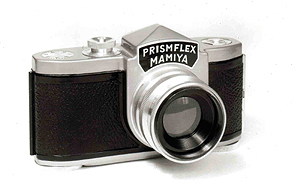
MAMIYA PRISM FLEX (above; c.1952),
the first MAMIYA SLR Prototype
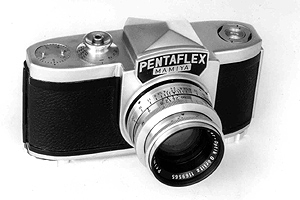
MAMIYA PENTAFLEX (above; c.1955),
the
second MAMIYA SLR Prototype
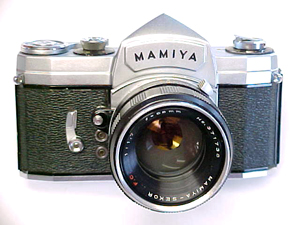
The first production MAMIYA PRISMAT
(above; c.1961)
Photo courtesy Ken Frey
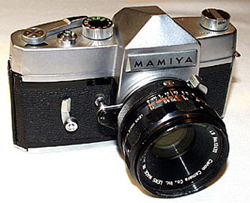
MAMIYA PRISMAT NP (above; c.1961),
with 50mm Canon OM f/1.9 lens in an Exata mount
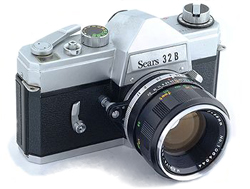
SEARS 32B (above)
a re-branded PRISMAT NP (c.1963)
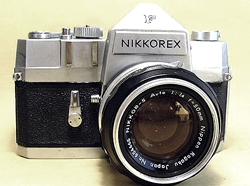
NIKKOREX F, made for Nikon by MAMIYA (above; c.1962)
The Nikkorex F
Mamiya produced a camera for Nippon Kogaku (Nikon)
similar to the Prismat NP, using a standard Nikon F lens mount. It
was introduced in 1962 by Nikon as the Nikkorex F. It was the
first camera fitted with the new metal Copal S vertical-travel focal
plane shutter, and it beat the introduction of a similar shutter on
the Nikon Nikkormat by a full three years. The Nikkorex F, particularly
one found in good working order, is very much sought after today by
both Nikon and Mamiya collectors.
Later, this same camera from Mamiya can be seen in the Nikon-mount
Ricoh Singlex. A version was also marketed in Germany as the
Nikkor J. Mamiya also made the Nikkorex Zoom 35 (not
pictured). It featured a fixed 43-86mm f/3.5 Nikkor Auto Zoom lens,
with a Porro-mirror reflex finder and a coupled selenium meter.
For more Nikkorex information,
scroll about halfway down this page from the
Nikon Historical Society!
|
Prototype Mamiya SLR
 New information and
pictures from Mamiya Japan are even more interesting to me. They
indicate there were two Mamiya prototype SLR models that
preceded the Mamiya Prismat. In fact, they preceded most of the
camera-making world, making Mamiya one of the early developers of
the 35mm SLR! New information and
pictures from Mamiya Japan are even more interesting to me. They
indicate there were two Mamiya prototype SLR models that
preceded the Mamiya Prismat. In fact, they preceded most of the
camera-making world, making Mamiya one of the early developers of
the 35mm SLR!
It is an accepted historic fact that the odd-looking Russian GOMZ
Sport (c.1935) was the first 35mm SLR. Ihagee (a Dutch company totally
destroyed in WWII), introduced the Kine-Exakta 35mm SLR in 1936.
However, neither of these innovative cameras used a pentaprism.
The honor of being the first pentaprism SLR is generally acknowledged
to have been the Zeiss Ikon Contax S (c.1950).
 

ABOVE: GOMZ Sport (c.1935),
Ihagee Kine-EXATA (c.1936), and ZEISS IKON CONTAX S (c.1950)
However, Mamiya was not far behind in SLR development. In October
1951, the Japanese Ministry of International Trade and Industry
(MITI), obviously understanding the innovation the SLR would bring
to the camera industry, contributed a very large sum to assist Mamiya
in the development of their own single lens reflex camera.
The Mamiya Prismflex prototype was available by 1952. The
second prototype, the Mamiya Pentaflex was created in early
1955. My research into how many of each prototype were produced
-- and the specifics of their construction -- is not yet
complete, but Mamiya innovation is clear.
In truth, Mamiya beat most of their competition
to everything but the market. The
Miranda Orion did not debut until 1956.
Asahi did not release their first
Pentax model until 1957. Minolta's
SR-2 was not released until 1958. The seldom discussed,
and short-lived camera from lensmaker
Zunow also appeared -- and disappeared -- in 1958.The
Canonflex
was not released until 1959, as was Nippon Kogaku's Nikon
F -- which, as we all know, quickly cornered the market.
Why didn't Mamiya enter the SLR market with the Prismat until 1961?
That is an open and intriguing question, since they had clearly
been working on 35mm SLR development for the previous 10 years!
Mamiya Prismat NP
The Mamiya Prismat NP, released in February 1961, was Mamiya's
first production single-lens reflex (SLR) 35mm. The very first Prismat
is readily identifiable by its distinctive curved nameplate on the
front of the prism housing.
It was soon updated to the more familiar rectangular Mamiya nameplate
(left). It has no meter, and its available lenses featured a semi-automatic
aperture with an external Exacta-type linkage (actually introduced
by Ihagee) for aperture function. The known Mamiya-Sekor F.C. lenses
include a 35mm f/2.8; a 48mm f/2.8; a 58mm f/1.7; and a 135mm f/2.8.
There was also a 50mm f/1.9 available, made by Canon (see photo, left).
Pressing the shutter release button on the NP, a
small bolt moves out of the camera body and presses the related
button (c) on the lens, closing the aperture (see picture below).
After the exposure, the aperture remains closed and has to be opened
with lever (a). The f-stop is locked on those lenses, and is changed
by pressing button (b).
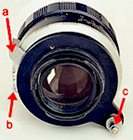 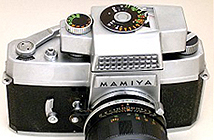
Aperture mechanism, 58mm MAMIYA
F.C. f/1.7 lens (left); clip-on exposure meter (right)
The horizontal cloth focal-plane shutter has speeds
from 1 to 1/1000, plus B and T. It also features FP and X sync receptacles
and a self timer. It also featured an optional clip-on exposure
meter which fits over the prism and coupled to the shutter speed
dial. Typically equipped with a Mamiya FC 58mm f/1.7 lens, other
manufacturers also made lenses for the Prismat NP.
A Prismat NP version was marketed in the UK as either the Mamiya
Prismatic (c.1962), or the Mamiya Reflexa (c.1963), and
both cameras were often sold with the optional 50mm f/1.9
Canon OM lens in an Exacta-bayonet mount.
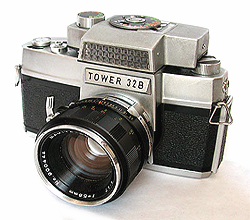
TOWER (Mamiya) 32B, with optional clip-on
exposure meter
The Prismat NP was also sold (c.1963) through Sears, as the Sears
32A and later the Tower 32B and Sears 32B. A version
of the NP with a vertical-travel, metal focal plane shutter was
also sold as the Sears SLII. Yet another version, with a unique bayonet
mount unlike the others, was manufactured by Mamiya for Argus.
A table of known
Mamiya Prismat clones.
 |
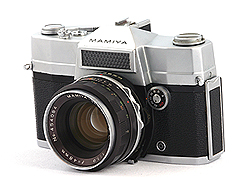
MAMIYA PRISMAT PH (above; c.1961)
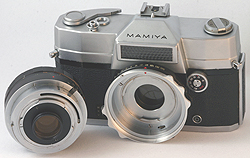
The truly unique PRISMAT PH bayonet mount (above) |
Mamiya Prismat PH
Released in July 1961, the Prismat PH, pictured
at left, was Mamiya's first leaf-shutter 35mm SLR (the Prismat NP,
seen above, was their first SLR). The shutter was built into the camera
body, not the lens. The Prismat PH has a selenium-cell meter mounted
on the front of a fixed prism, and features a Seikosha-SLV behind-the-lens
leaf shutter with speeds from 1 to 1/500. The shutter-speed dial is
on the front of the body, and the camera came standard with a 48mm
f/1.9 interchangeable bayonet-mount lens. The Prismat PH was also
sold through Photronic Corporation of America as the rebranded Prismat
PCA V-90.
Yet another version of the Prismat PH, without the selenium cell or
CdS meter, was sold through Sears as the Tower 37 (c.1961).
All versions had a truly unique bayonet-mount. All versions are also
rare today in working order, and are considered a nice prize by Mamiya
collectors.

The available PRISMAT PH lenses: 38mm f/3.5; 48mm f/1.9 and 100mm f/3.5
Photo courtesy R. Stauber |

MAMIYA PRISMAT CPH with CdS meter (above; c.1963)
|
Mamiya Prismat CPH
There is little available information about it (little
I have been able to find, at any rate), but a version of the Mamiya PH,
known as the Mamiya CPH (left; c.1963), was produced with a round
CdS meter positioned on the camera face, just below the rewind knob. It
also had a truly unique bayonet lens mount.

The equally unique CPH mount (above)
|

MAMIYA PRISMAT CWP (above; c.1964)
CLICK HERE
for CWP (CP)
lens & accessory
information

ABOVE: MAMIYA CWP meter

|
Mamiya CWP
The Mamiya CWP was introduced in August 1964.
The CWP designation was used exclusively in the USA. Elsewhere it
was known as the Mamiya CP. It is known that it could have
either Mamiya or Mamiya/Sekor body nameplates.
It came with a 58mm f/1.7 Mamiya-Sekor lens, with a fully automatic
aperture. CWP lenses used the 42mm thread mount for the first time,
something Mamiya would continue in their TL- and DTL-series cameras.
The CWP had a CdS exposure meter on the front plate. The meter is
not coupled to the diaphragm and, rather than reading through the
lens, the metered f-stop is viewed in a small window on top of the
camera.
The meter was originally powered by a 1.3v PX625 mercury battery,
and mercury batteries are no longer available. Usable replacement
batteries are the 1.5v A625PX alkaline battery or the Z625PX zinc-air
battery, which can both be
purchased online.
With synch for both bulb and electronic flash, the CWP has a horizontal
cloth focal-plane shutter with speeds from 1 to 1/1000; a self-timer;
and came with a full complement of optional, interchangeable lenses.
A rugged and dependable camera, the Mamiya Prismat CWP is still found in auction
today, and working models can bring a reasonably good price, although
good users are becoming increasingly rare.
|
© 2000-2010 R.L. Herron
All Rights Reserved. Legal
|